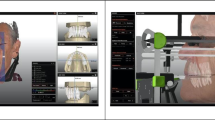Abstract
Purpose
The accuracy of fully digital model–free surgical and prosthetic procedures depends on the cumulative effect and interaction of all errors gathered along the entire workflow process. In the present case series, a technique is described that increases the accuracy in the transition from the surgical to the prosthetic phase to reduce the risk of developing prosthetic complications in the case of immediate loading protocols.
Methods
Overall, 86 dental implants were placed and immediately loaded with definitive prostheses in 11 edentulous patients following computer-guided implant surgery according to a fully digital model–free workflow. The same reference template used to anchor the surgical stent during computer-aided implant placement was used to guide the insertion of the definitive abutments and to seat in the correct position the final screw-retained implant-supported fixed restoration. The template used during all surgical and prosthetic procedures, which served as a stable and reproducible connection between the digital and surgical environments, was finally removed.
Results
Healing proceeded uneventfully in all subjects. The implant survival and success rates were 100% over a minimum follow-up period of 1 year from the prosthetic loading. No biological or prosthetic complications were clinically and radiographically observed up to the last follow-up recall.
Conclusion
The use of a reference template used to transfer the digital project to the surgical field increased the accuracy and the integration of the surgical and prosthetic phases during the entire workflow.













Similar content being viewed by others
References
Orentlicher G, Horowitz A, Kobren L (2019) Computer-guided dental implant treatment of complete arch restoration of edentulous and terminal dentition patients. Oral Maxillofac Surg Clin North Am 31(3):399–426. https://doi.org/10.1016/j.coms.2019.03.004
Beretta M, Poli PP, Tansella S, Aguzzi M, Meoli A, Maiorana C (2020) Cast-free digital workflow for implant-supported rehabilitation in a completely edentulous patient: a clinical report. J Prosthet Dent. https://doi.org/10.1016/j.prosdent.2019.12.009
Al Yafi F, Camenisch B, Al-Sabbagh M (2019) Is digital guided implant surgery accurate and reliable? Dent Clin N Am 63(3):381–397. https://doi.org/10.1016/j.cden.2019.02.006
Patzelt SB, Vonau S, Stampf S, Att W (2013) Assessing the feasibility and accuracy of digitizing edentulous jaws. J Am Dent Assoc 144(8):914–920
Beretta M, Poli PP, Tansella S, Maiorana C (2018) Virtually guided alveolar ridge reduction combined with computer-aided implant placement for a bimaxillary implant-supported rehabilitation: a clinical report. J Prosthet Dent 120:168–172. https://doi.org/10.1016/j.prosdent.2017.11.010
Beretta M, Poli PP, Maiorana C (2014) Accuracy of computer-aided template-guided oral implant placement: a prospective clinical study. J Periodontal Implant Sci 44(4):184–193. https://doi.org/10.5051/jpis.2014.44.4.184
Schneider D, Marquardt P, Zwahlen M, Jung RE (2009) A systematic review on the accuracy and the clinical outcome of computer-guided template-based implant dentistry. Clin Oral Implants Res 20(Suppl 4):73–86. https://doi.org/10.1111/j.1600-0501.2009.01788.x
Tahmaseb A, Wismeijer D, Coucke W, Derksen W (2014) Computer technology applications in surgical implant dentistry: a systematic review. Int J Oral Maxillofac Implants 29(Suppl):25–42. https://doi.org/10.11607/jomi.2014suppl.g1.2
Baruffaldi A, Poli PP, Baruffaldi A, Giberti L, Pigozzo M, Maiorana C (2016) Computer-aided flapless implant surgery and immediate loading. A technical note. Oral Maxillofac Surg 20(3):313–319. https://doi.org/10.1007/s10006-016-0554-5
Coachman C, Calamita MA, Sesma N (2017) Dynamic documentation of the smile and the 2D/3D digital smile design process. Int J Periodontics Restorative Dent 37(2):183–193. https://doi.org/10.11607/prd.2911
ten Bruggenkate CM, van der Kwast WA, Oosterbeek HS (1990) Success criteria in oral implantology. A review of the literature. Int J Oral Implantol 7(1):45–51
Meloni SM, De Riu G, Pisano M, Tullio A (2013) Full arch restoration with computer-assisted implant surgery and immediate loading in edentulous ridges with dental fresh extraction sockets. One year results of 10 consecutively treated patients: guided implant surgery and extraction sockets. J Maxillofac Oral Surg 12(3):321–325. https://doi.org/10.1007/s12663-012-0429-8
Schnutenhaus S, Edelmann C, Rudolph H, Dreyhaupt J, Luthardt RG (2018) 3D accuracy of implant positions in template-guided implant placement as a function of the remaining teeth and the surgical procedure: a retrospective study. Clin Oral Investig 22(6):2363–2372. https://doi.org/10.1007/s00784-018-2339-8
Albiero AM, Quartuccio L, Benato A, Benato R (2019) Accuracy of computer-guided flapless implant surgery in fully edentulous arches and in edentulous arches with fresh extraction sockets. Implant Dent 28(3):256–264. https://doi.org/10.1097/id.0000000000000878
Colombo M, Mangano C, Mijiritsky E, Krebs M, Hauschild U, Fortin T (2017) Clinical applications and effectiveness of guided implant surgery: a critical review based on randomized controlled trials. BMC Oral Health 17(1):150. https://doi.org/10.1186/s12903-017-0441-y
Tahmaseb A, De Clerck R, Aartman I, Wismeijer D (2012) Digital protocol for reference-based guided surgery and immediate loading: a prospective clinical study. Int J Oral Maxillofac Implants 27(5):1258–1270
Rungcharassaeng K, Caruso JM, Kan JY, Schutyser F, Boumans T (2015) Accuracy of computer-guided surgery: a comparison of operator experience. J Prosthet Dent 114(3):407–413. https://doi.org/10.1016/j.prosdent.2015.04.004
Marei HF, Abdel-Hady A, Al-Khalifa K, Al-Mahalawy H (2019) Influence of surgeon experience on the accuracy of implant placement via a partially computer-guided surgical protocol. Int J Oral Maxillofac Implants. https://doi.org/10.11607/jomi.7480
Author information
Authors and Affiliations
Corresponding author
Additional information
Publisher’s note
Springer Nature remains neutral with regard to jurisdictional claims in published maps and institutional affiliations.
Rights and permissions
About this article
Cite this article
Baruffaldi, A., Baruffaldi, A., Baruffaldi, M. et al. A suggested protocol to increase the accuracy of prosthetic phases in case of full-arch model-free fully guided computer-aided implant placement and immediate loading. Oral Maxillofac Surg 24, 343–351 (2020). https://doi.org/10.1007/s10006-020-00849-4
Received:
Accepted:
Published:
Issue Date:
DOI: https://doi.org/10.1007/s10006-020-00849-4




